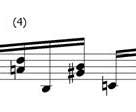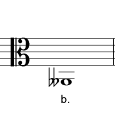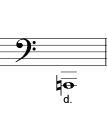Hover your mouse over the questions (tap on mobiles) to reveal the answers.
* This test contains SEVEN questions, ALL of which should be answered.
* Points available for each question are given in brackets e.g. (2 points)
Maximum score=100. Score of 66-79=pass, 80-89=merit and 90+=distinction. Score of less than 66 is a fail.
Time limit: 2 hours.
(This test is designed for laptop screens, not mobiles) New test coming soon!)
1. This extract is from a bassoon concerto by Mozart. Look at it then answer the questions that follow.


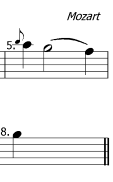
(a) Put in the time signature at the beginning. (2 points) (Hover mouse over bar 1 for answer)
(b) Add the correct rest(s) to complete bar 8. (2 points) (Hover mouse over bar 8 for answer)
2. Describe fully (e.g. minor 2nd, perfect 5th) the numbered harmonic intervals in this passage. (10 points)
img
3. Choose the correct answer for each term/symbol. (10 points)
- Allegro:

- Maestoso:
- En pressant:
- Tanto:
4. Name each of these notes, as shown in the first answer. (10 points)

5. Look at this melody by Gallay and then answer the questions that follow.
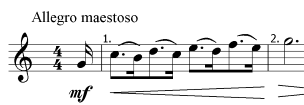
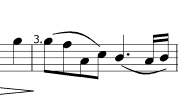




- Name one similarity and one difference between bars 5 and 6.
i. Similarity:ii. Difference: - Draw a circle round two notes which are a minor 6th apart and mark them with the letter A. (2 points) (Hover mouse over score to reveal answer)
- Rewrite bar 3 using notes of twice the value. Remember to include the new time signature. (5 points)

- Rewrite the notes of bar 6 so that they sound the same but using the alto clef. Remember to put in the clef. (4 points)

- oboe – timpani – bassoon – violin – clarinet
- Draw a square bracket (
 ) over four notes next to each other which form part of a chromatic scale, and mark it with the letter B. (2 points) (Hover mouse over score to reveal answer)
) over four notes next to each other which form part of a chromatic scale, and mark it with the letter B. (2 points) (Hover mouse over score to reveal answer) 
- Draw a circle round three notes next to each other that form the tonic triad, and mark them with the letter C. The key is C major. (2 points)
- This melody was written for the horn. Complete the following statements: (4 points)
6. (a) Put sharps or flats in front of the notes that need them to make the scale of G# melodic minor. Do not use a key signature. (5 points)

(b) Put all necessary sharps, flats or naturals in front of these notes to make a chromatic scale. (5 points)

7. Name each of these numbered chords as tonic (I), subdominant (IV) or dominant (V). The key is Eb major. (9 points)

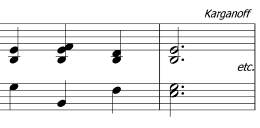
8. Write the key signatures and triads named below. (6 points)






